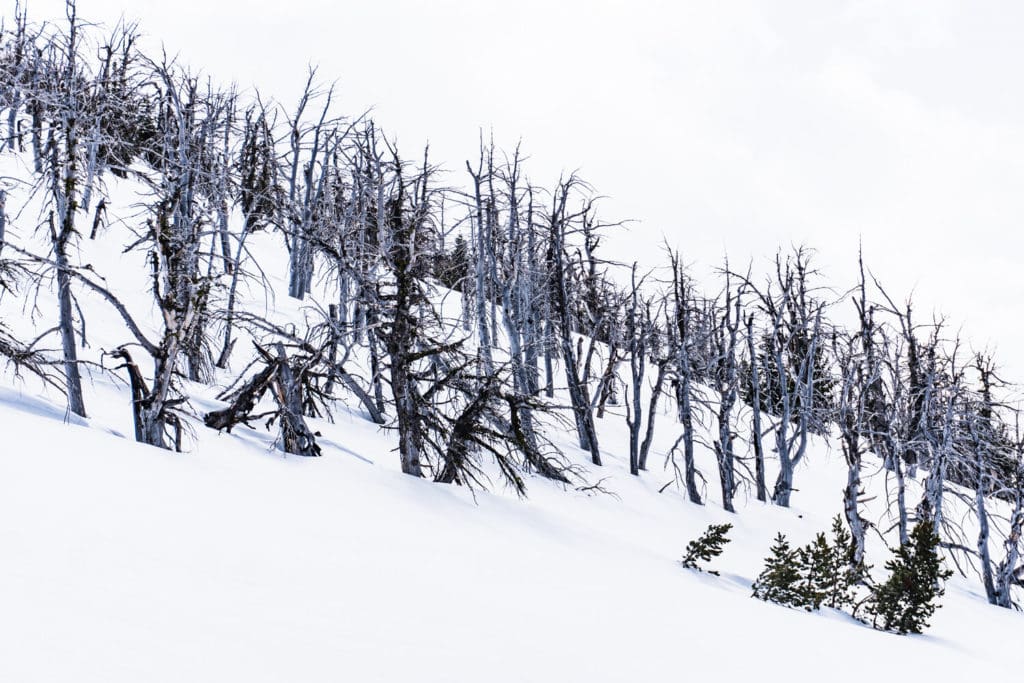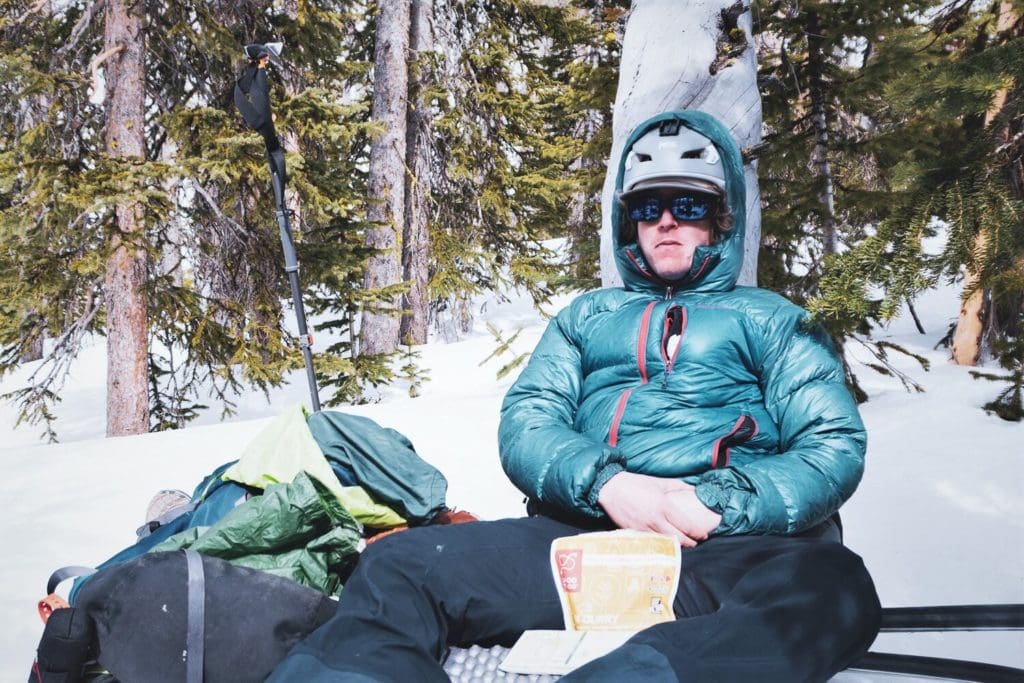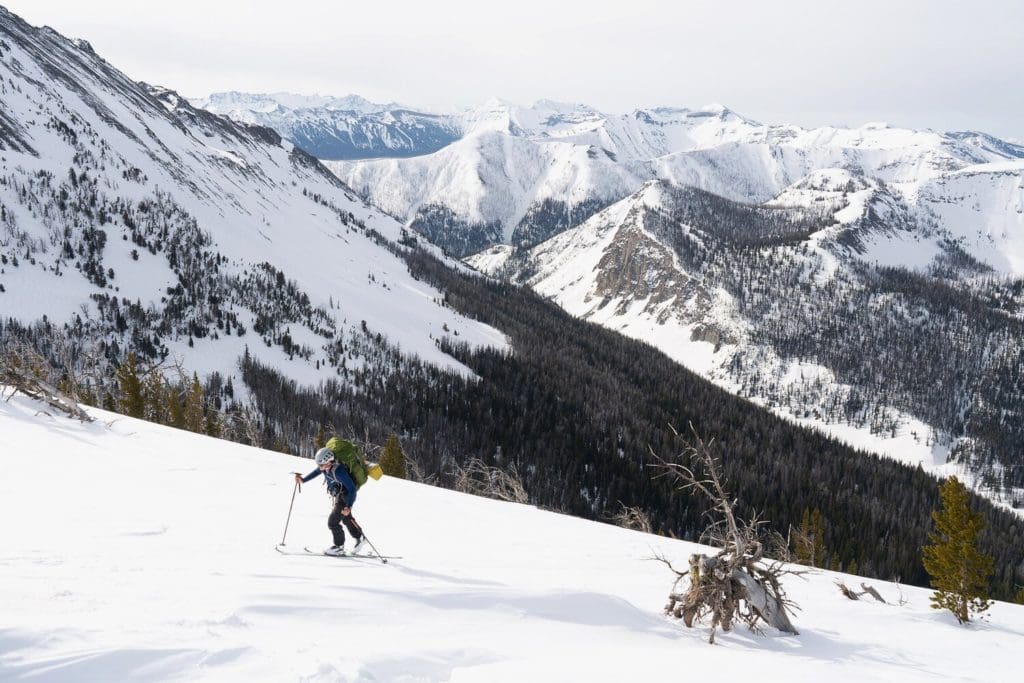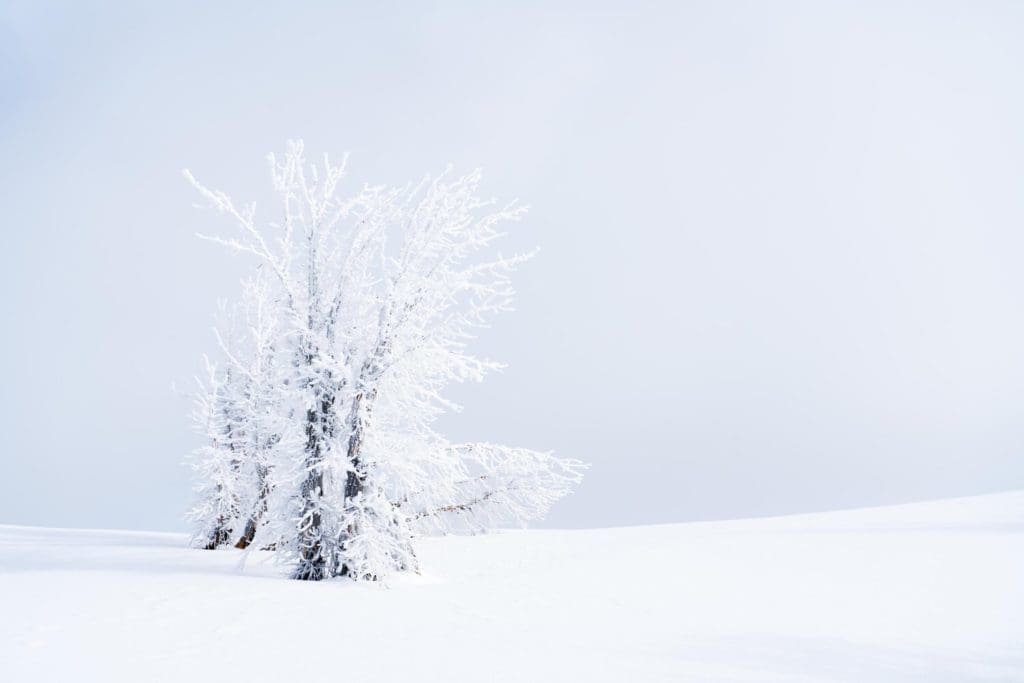In spring 2019, Y2Y supported adventurer and visual storyteller Anthony Pavkovich through a partner grant to complete a ski traverse of the Absaroka Range, a series of mountains in Wyoming. His intention was to learn more about an iconic tree of the west’s mountain ranges: the whitebark pine.
Whitebark pine are found at the highest and coldest locations across the Yellowstone to Yukon region. Important food for grizzly bears, these ancient, rare trees are disappearing as mountain pine beetles, helped by climate change, ravage them.
Anthony became quite ill during the trip and eventually had to call it off. Today we’re sharing this guest post where he talks about his adventure and findings up until that unfortunate moment.
The first day was rough.
By late afternoon, I was exhausted and sat violently shivering in all my layers surrounded by a dying forest. Sweat plastered my hair to my forehead as I stared past the rim of my cup, beyond my muddy ski boots and across a glacial valley that marked the edge of Yellowstone National Park.
At 9000 feet, the bright sun beat down on me and I dipped in and out of reality.
It was going to be a long and uncomfortable night.
Across the Greater Yellowstone Ecosystem — an area that stretches from Bozeman, Montana to Cody, Wyoming and Driggs, Idaho — silvery, dead forests cling to the steep mountainsides. As more and more of the mature trees die, the gnarled and bushy whitebark pine forests are nearing a point of no return.
Since the turn of the century, whitebark pine — an iconic tree of the West’s high mountains — has been decimated by outbreaks of the native mountain pine beetles that have spread due to a rapidly warming climate. The beetle, which now thrives in previously inhospitable whitebark forests, bores into and kills mature trees.
The formerly vibrant forests are disappearing at an alarming rate and entire mountainsides, like those that cover Avalanche Peak near Yellowstone National Park’s east entrance, are now haunting stands of gray, lifeless snags.

Whitebark pines once thrived from Wyoming’s southern Wind Rivers, through Yellowstone National Park and north in Alberta and British Columbia. The trees are a keystone species of high-altitude ecosystems that stabilize and shade winter’s snowpack and provide a critical food source for grizzly bears. The tree’s decline was a key factor that kept the bears on the endangered species list.
According to the U.S. Fish and Wildlife Service — the agency instructed by Congress to manage threatened and endangered species — the pine will likely go extinct across much of its U.S. range in the next century.
However, due to a lack of funding and other priorities, the U.S Fish and Wildlife Service has yet to give the species federal protected status in the ecosystem.
Before my fever set stopped me in my tracks, I had set out with my friend, Zach Altman, to ski along the northeast border of Yellowstone National Park and bear witness to the ecosystem’s widespread loss of whitebark pine.
We had planned a weeklong ski tour through the mountains above the Lamar River, Hoodoo Basin, Cooke City, Pebble Creek and the Gardiner Hole. After months of planning, and years of dreaming, we had set out to see firsthand what approaching extinction looks like in our home ecosystem.
But, after a fitful and frightening night’s sleep above the North Fork of the Shoshone River, I awoke shivering in a sweat drenched sleeping bag. Though my fever momentarily broke, the heat from my fever had radiated and I had melted my way down into the spring snowpack.
Altman, who is typically the only voice of reason between the two of us, looked at me frightened and worried as I woke. As he checked to make sure I was coherent, he recounted how I thrashed about all night and muttered terrifyingly in my sleep.
He firmly said that he didn’t feel comfortable with continuing forward on our trip with me in such a dire condition.
Without much of an argument, he texted his wife on the satellite phone, dug out our best snacks for breakfast and slowly packed up camp to ski back towards the highway.
With my weakened state, our retreat wasn’t guaranteed.

Thirty miles further north, as the crow flies, Dr. Jesse Logan winters in the tiny town of Cooke City, Montana. He lives in half of a small cabin with his wife, across from the town’s only bakery, and devotes his winters to backcountry skiing.
In his mid-seventies and athletic, Logan skis over 100 days per year and the only noticeable sign of his age is the white beard beneath his ski goggles.
Now retired, he was the head entomologist for the beetle research unit at the U.S. Forest Service’s Logan Forestry Sciences Laboratory in Utah, until 2007.
More than two decades ago, Logan made the dire prediction that with global warming, the mountain pine beetle — which has historically targeted lodgepole and ponderosa pines at lower elevations — would ravage the forests that cover the mountains across the Greater Yellowstone Ecosystem.
Beginning with his first winter in Cooke City, he’s tracked the changes to his backyard from one ski season to the next. In recent years, with shorter and less extreme winters, mountain pine beetles have taken hold in the forests above Logan’s home.
“I think the time to act was 30 years ago,” said Logan.
Besides a few last refugia, the whitebark pine forests have turned from green to red to gray as the insects spread across the mountainsides.
While out skiing, Dr. Logan searches for and marks the healthy stands of whitebark that he finds on his GPS. While whitebark pines grow predominantly at elevations higher than 8,500 feet above sea level, Dr. Logan distinguishes the trees from the more common Douglas fir and lodgepole pine by their telltale clusters of five needles.
“I think the time to act (on mountain pine beetles) was 30 years ago.
Dr. Jesse Logan, retired entomologist, U.S. Forest Service
Each ski season, he observes a widening area of infestation.
Looking closely at the infested trees, the first noticeable signs of an outbreak are little holes and bits of residue on the bark where the beetles —roughly the size of a grain of rice — entered and laid their eggs.
The beetle larva eats the cambium, the layer between the trunk and the bark, and can quickly kill a tree that could have otherwise lived for over 1000 years.
While the beetles don’t attack young trees, they wipe out the mature trees across large areas of forest. Whitebark pines are slow to mature and rarely bear cones until they are over 50 years old and peak cone production isn’t reached until around 200 years. When the beetles wipe out the cone bearing trees, they prevent the forest from reseeding.
With only young trees left, there are no seeds to feed wildlife and old snags no longer shade the snow with their broad canopies. The trees don’t grow back.
Reversing our traverse, Altman and I skied back along the crest of the Absarokas and through the ghost forests flanking Avalanche Peak.
My heavy bag and fever slowed me down as the morning sun rose above the Yellowstone Plateau. Light flickered from the patches of ice and open water of Yellowstone Lake.
As we slogged to the top of an unnamed pass on the park boundary, we realized we weren’t the only animals crossing the range.
Summiting the pass and heading down towards the highway, our skis crossed large grizzly tracks pressed into the soft snow. Having recently emerged from its den in the mountains, the bear was looking for food and likely headed for the melted meadows around Yellowstone’s thermal features.
Later in the year, bears would traditionally return to these mountains and feast on the fatty seeds of the whitebark pine. However, in the dead forest around us, the rich pine nuts were no longer produced to fatten the bears up for winter.
Crossing the tracks, I quickly checked to make sure my bear spray was still secured to my hip before proceeding through the silver trees.
A few thousand feet below, the highway snaked through the foothills and one more run through the sparse trees was all that remained of our shortened ski trip.
I took one final look along the sinuous arch of the range stretching north behind me before dropping into a series of smooth turns towards our partners, a ride home and cold medicine.

As whitebark pines head down the path of extinction, the high plateaus of the Beartooth Mountains, just north of Cooke City, may be the trees’ final refuge. According to Dr. Logan, these currently treeless, alpine plateaus provide one of the last high elevation zones for the trees to potentially migrate.
With help, either from natural dispersion by the Clarks nutcracker or by focused intervention by humans, the tree may reach the high, cold plateaus above the pine beetle range.
Even if climate change can be slowed or stopped in the next ten years, the loss of these forests is unlikely to be reversed.
It’s only a matter of time until fire consumes Yellowstone’s ghost forests. During a dry summer, a bolt of lightning will likely strike high on a ridgeline and flames will roar from crown to crown among the silver trees.
With most of the mature trees long dead, there will be no source of whitebark pine seeds to naturally replant Yellowstone’s charred mountainsides. Instead, as the climate warms, wildflowers and young Douglas fir will slowly replace the ecosystem’s ancient forests.
Already, whitebark pine may be functionally extinct.
The long drive home from the park left time for me to reflect.
It didn’t feel right to give up on a project but there was the consolation of next year and the chance to try again.
However, for Yellowstone’s whitebark, it’s most likely too late. Talking with Dr. Logan as well as scientists at the Whitebark Pine Foundation, without serious and direct human intervention, the remaining whitebark forests will slowly blink out.
The time to act for whitebark was 30 years ago. Now, our focus needs to shift to other species we can still save from extinction.
As the truck sped down the highway and out of the mountains, I drifted into a fitful sleep.


